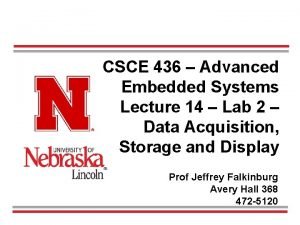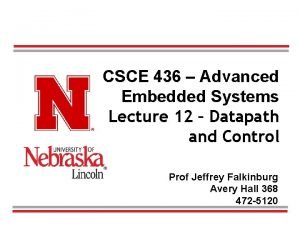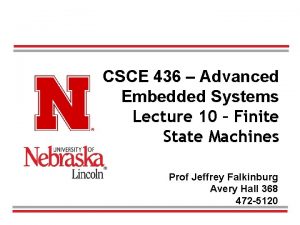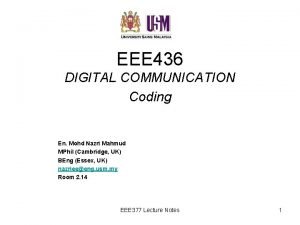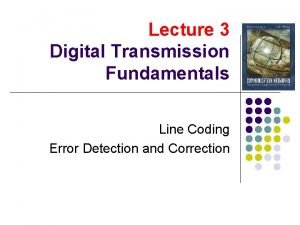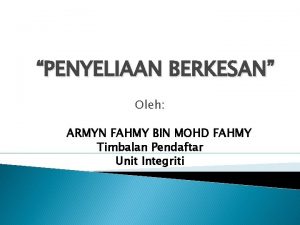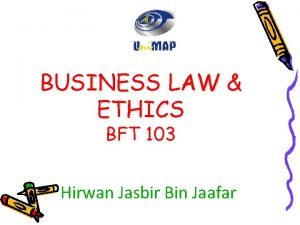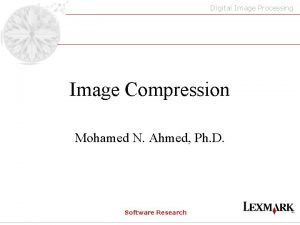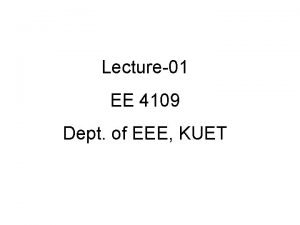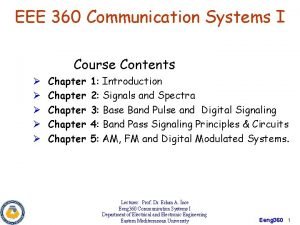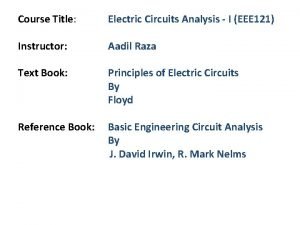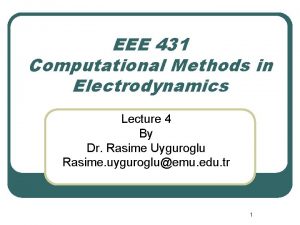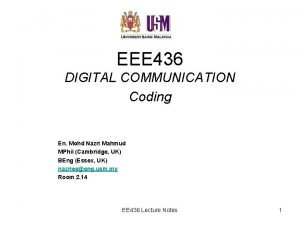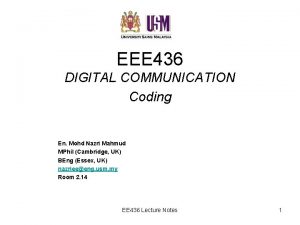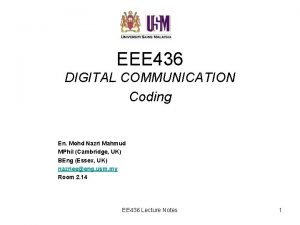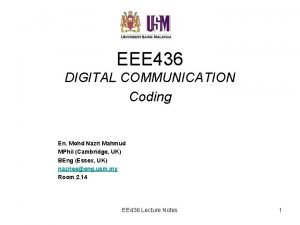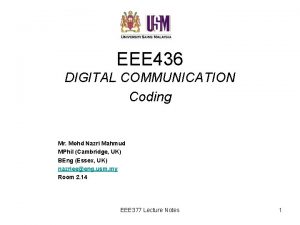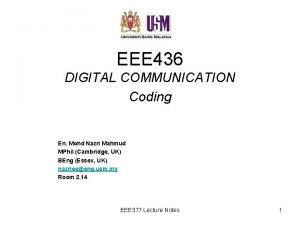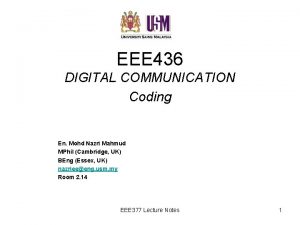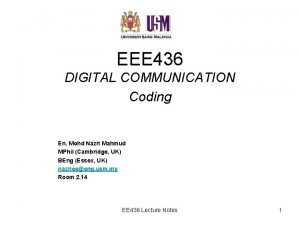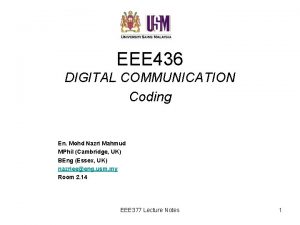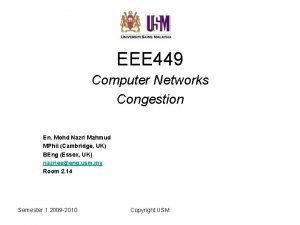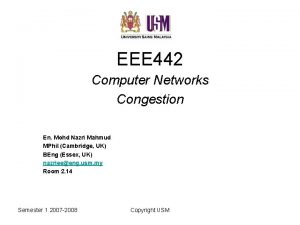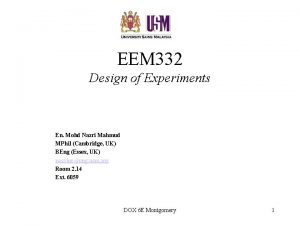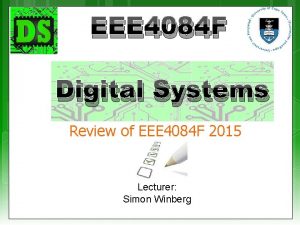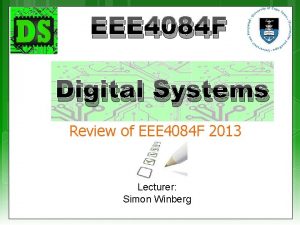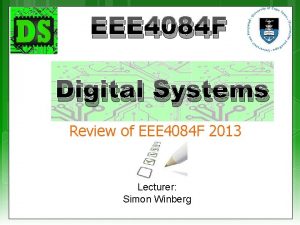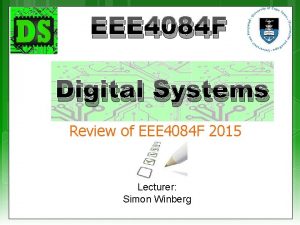EEE 436 DIGITAL COMMUNICATION Coding En Mohd Nazri





























- Slides: 29

EEE 436 DIGITAL COMMUNICATION Coding En. Mohd Nazri Mahmud MPhil (Cambridge, UK) BEng (Essex, UK) nazriee@eng. usm. my Room 2. 14 EEE 377 Lecture Notes 1

Source Coding Source encoding is the efficient representation of data generated by a source. For an efficient source encoding, knowledge of the statistics of the source is required. If some source symbols are more probable than others, we can assign short code words to frequent symbols and long code words to rare source symbols. EEE 377 Lecture Notes 2

Source Coding Consider a discrete source whose output of k different symbols sk is converted by the source encoder into a block of 0 s and 1 s denoted by bk Assume that the kth symbol, sk occurs with probability pk , k=0, 1…. . K-1. Let the binary code word assigned to symbol sk have length lk (in bits) Therefore the average code-word length of the source encoder is given by EEE 377 Lecture Notes 3

Source Coding Let Lmin denotes the minimum possible value of code-word length The Coding efficiency of the source encoder is given by EEE 377 Lecture Notes 4

Data Compaction Data compaction is important because signals generated contain a significant amount of redundant info and waste communication resources during transmission. For efficient transmission, the redundant info should be removed prior to transmission. Data compaction is achieved by assigning short description to the most frequent outcomes of the source output and longer description to the less frequent ones. Some source-coding schemes for data compaction: • Prefix coding • The Huffman Coding • The Lempel-Ziv Coding EEE 377 Lecture Notes 5

Prefix Coding A prefix code is a code in which no code word is the prefix of any other code word Example: Consider the three source codes described below Source Symbol Probability of Occurrence Code III s 0 0. 5 0 0 0 s 1 0. 25 1 10 01 s 2 0. 125 00 110 011 s 3 0. 125 11 111 0111 EEE 377 Lecture Notes 6

Prefix Coding Source Symbol Probability of Occurrence Code III s 0 0. 5 0 0 0 s 1 0. 25 1 10 01 s 2 0. 125 00 110 011 s 3 0. 125 11 111 0111 Is Code I a prefix code? It is NOT a prefix code since the bit 0, the code word for s 0, is a prefix of 00, the code word for s 2 and the bit 1, the code word for s 1, is a prefix of 11, the code word for s 3. Is Code II a prefix code? Yes A prefix code has the important property that it is always uniquely decodable Is Code III a prefix code? No EEE 377 Lecture Notes 7

Prefix Coding - Example Source Symbol Code III x Code IV s 0 0 00 s 1 10 01 01 01 s 2 110 001 011 10 s 3 1110 0010 110 s 4 1111 0011 111 ü x ü Prefix code? EEE 377 Lecture Notes 8

Huffman Coding – a type of prefix code Basic idea : Assign to each symbol a sequence of bits roughly equal in length to the amount of information conveyed by the symbol. Huffman encoding algorithm: Step 1: The source symbols are listed in order of decreasing probability. The two source symbols of lowest probability are assigned a 0 and 1. Step 2: These two source symbols are regarded as being combined into a new source symbol with probability equal to the sum of the two original probabilities. The probability of the new symbol is placed in the list in accordance with its value. The procedure is repeated until we are left with a final list of symbols of only two for which a 0 and 1 are assigned. The code for each source symbol is found by working backward and tracing the sequence of 0 s and 1 s assigned to that symbol as well as its successors. EEE 377 Lecture Notes 9

Huffman Coding – Example Step 1: The source symbols are listed in order of decreasing probability. The two source symbols of lowest probability are assigned a 0 and 1. Step 2: These two source symbols are regarded as being combined into a new source symbol with probability equal to the sum of the two original probabilities. The probability of the new symbol is placed in the list in accordance with its value. The procedure is repeated until we are left with a final list of symbols of only two for which a 0 and 1 are assigned. The code for each source symbol is found by working backward and tracing the sequence of 0 s and 1 s assigned to that symbol as well as its successors. EEE 377 Lecture Notes 10

Huffman Coding – Average Code Length = 0. 4(2) + 0. 2(2) + 0. 1(3) = 2. 2 EEE 377 Lecture Notes 11

Huffman Coding – Exercise Symbol S 0 S 1 S 2 Probability 0. 7 0. 15 Compute the Huffman code. What is the average code-word length? EEE 377 Lecture Notes 12

Huffman Coding – Exercise EEE 377 Lecture Notes 13

Huffman Coding – Two variations When the probability of the combined symbol is found to equal another probability in the list, we may proceed by placing the probability of the new symbol as high as possible or as low as possible. EEE 377 Lecture Notes 14

Huffman Coding – Two variations EEE 377 Lecture Notes 15

Huffman Coding – Two variations EEE 377 Lecture Notes 16

Huffman Coding – Two variations Which one to choose? EEE 377 Lecture Notes 17

Huffman Coding – Exercise Symbol S 0 S 1 S 2 S 3 S 4 S 5 S 6 Probability 0. 25 0. 125 0. 0625 Compute the Huffman code by placing the probability of the combined symbol as high as possible. What is the average code-word length? EEE 377 Lecture Notes 18

Huffman Coding – Exercise Answer Symbol S 0 S 1 S 2 S 3 S 4 S 5 S 6 Probability 0. 25 0. 125 0. 0625 EEE 377 Lecture Notes 19

Huffman Coding – Exercise EEE 377 Lecture Notes 20

Huffman Coding – extended form The source is then extended to order two. EEE 377 Lecture Notes 21

Huffman Coding – extended form EEE 377 Lecture Notes 22

Lempel-Ziv Coding – a type of prefix code Basic idea : Parse the source data stream into segments that are the shortest subsequences not encountered previously Consider an input binary sequence 0001011100101… Assume that the binary symbols 0 and 1 are already stored Subsequences stored 0, 1 Data to be parsed 0001011100101… With symbols 0 and 1 already stored, the shortest subsequence encountered for the first time is 00, so Subsequences stored 0, 1, 00 Data to be parsed 01011100101… The second shortest subsequence not seen before is 01, so Subsequences stored 0, 1, 00, 01 Data to be parsed 011100101… EEE 377 Lecture Notes 23

Lempel-Ziv Coding – a type of prefix code The next shortest subsequence not seen before is 011, so Subsequences stored 0, 1, 00, 011 Data to be parsed 100101… Continue until the given data stream has been completely parsed Numerical Positions: 1 2 3 4 5 6 7 8 9 Subsequences: 1 00 01 011 10 010 101 0 Numerical representations: 62 Binary encoded blocks: 11 0010 0011 12 42 21 1001 0100 1000 EEE 377 Lecture Notes 41 1100 61 1101 24

Lempel-Ziv Coding – Exercise Encode the following sequence using Lempel-Ziv algorithm assuming that 0 and 1 are already stored 11101001100010110100…. EEE 377 Lecture Notes 25

Lempel-Ziv Coding – Exercise Answer Encode the following sequence using Lempel-Ziv algorithm assuming that 0 and 1 are already stored 11101001100010110100…. EEE 377 Lecture Notes 26

Lempel-Ziv Coding – Exercise Answer Encode the following sequence using Lempel-Ziv algorithm assuming that 0 and 1 are already stored 11101001100010110100…. EEE 377 Lecture Notes 27

Lempel-Ziv Coding – Exercise Answer Encode the following sequence using Lempel-Ziv algorithm assuming that 0 and 1 are already stored 11101001100010110100…. EEE 377 Lecture Notes 28

Lempel-Ziv Coding – Exercise Answer Encode the following sequence using Lempel-Ziv algorithm assuming that 0 and 1 are already stored 11101001100010110100…. 1000, EEE 377 Lecture Notes 29
 Ridzal sheriff
Ridzal sheriff Apa itu selective coding
Apa itu selective coding Contoh open coding, axial coding selective coding
Contoh open coding, axial coding selective coding Csce 436
Csce 436 Csce 436
Csce 436 Csce 436
Csce 436 Physical science 436
Physical science 436 Eee
Eee Nrz i
Nrz i History of qualitative research
History of qualitative research Coding dna and non coding dna
Coding dna and non coding dna Syahid mohd zain
Syahid mohd zain Armyn fahmy mohd fahmy
Armyn fahmy mohd fahmy Mohd talib latif
Mohd talib latif Sarah binti puteh
Sarah binti puteh Kesang leasing sdn bhd v mohd yusof bin ismail
Kesang leasing sdn bhd v mohd yusof bin ismail Merton miller
Merton miller Hiley formula
Hiley formula Putra mohd aidil rizal
Putra mohd aidil rizal Ain syafinaz mohd razip
Ain syafinaz mohd razip Wan mohd faizal
Wan mohd faizal الدائمون المحسنون بالهدى
الدائمون المحسنون بالهدى Error free compression in digital image processing
Error free compression in digital image processing Coding redundancy in digital image processing
Coding redundancy in digital image processing Image compression model in digital image processing
Image compression model in digital image processing Kuet eee
Kuet eee Eee 360
Eee 360 Eee 322
Eee 322 Eee 121
Eee 121 Eee 431
Eee 431



